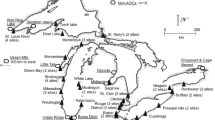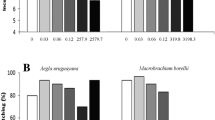Abstract
Data on reproductive success of Forster's tern (Sterna forsteri) from Green Bay, Lake Michigan in 1983 are compared with data collected in 1988. In 1988 measures of reproductive performance (hatching success, number of young fledged, and length of incubation) were improved. Concentrations of total polychlorinated biphenyls (PCBs) and planar PCB congeners in the eggs were compared between years. Median total PCB residue was 67% lower in 1988 (\(\bar X\)=7.3 μg/g). This corresponds to a 42% reduction in tetrachlorodibenzo-p-dioxin equivalents (TCDD-EQ) from 1983 to 1988. We suggest that contaminant reduction and improved reproductive performance were due to low river flows in 1988 and associated reduced PBC loading into Green Bay. Forty-two percent of the matured chicks died before fledgling, and their body weight growth curves were much lower than normal. Young accumulate total PCBs at a rate of 17.6 μg/day. A no-observable-adverse-effects level (NOAEL) of 40–84 μg/kg/day was estimated from the two year results using the least observable adverse effects level (LOAEL)/NOAEL rating values.
Similar content being viewed by others
References
Afifi AA, Clark V (1984) Computer aided multivariate analysis. Lifetime Learning Publications, Belmont, CA, 199 pp
Ankley GT, Niemi GJ, Lodge KB, Harris HJ, Beaver DL, Tillitt DE, Jones PD, Giesy JP, Hagley C (1993) Bioaccumulation of planar polychlorinated biphenyls and 2,3,7,8-substituted polychlorinated dibenzofurans and dibenzo-p-dioxins by four species of birds species of birds nesting along the lower Fox River/Green Bay, Wisconsin. Arch Environ Contam Toxicol 24:332–344
Ankley GT, Lodge K, Call DJ, Balcer MD, Brooke LT, Cook PM, Kreis RG, Carlson AR, Johnson RD, Niemi GJ, Hoke RA, West CW, Giesy JP, Jones PD, Fuying ZC (1992) Integrated assessment of contaminated sediments in the lower Fox River and Green Bay, Wisconsin. Ecotoxicol Environ Saf 23:46–63
Baldwin SP, Obeholser HC, Worley LG (1931) Scientific Publications of Cleveland Museum of Natural History, Vol II, 165 pp
Bierman VJ, Depinto JV, Young TC, Rogers PW, Martin SC (1992) Development and validation of an integrated exposure model for toxic chemicals in Green Bay, Lake Michigan. The Large Lakes Research Station USEPA, Grosse Isle, Michigan (draft report)
DeRosa CT, Stara JF, Durkin PR (1985) Ranking chemicals based on chronic toxicity data. Toxicol Ind Health 1:177–191
Evans MS (ed) (1988) Toxic contaminants and ecosystem health: A Great Lakes focus, Vol 21, Wiley Series Advances in Environmental Science and Technology. John Wiley and Sons, NY, 602 pp
Gailani J, Ziegler CK, Lick W (1991) Transport of suspended solids in the lower Fox River. J Gt Lakes Res 17:479–494
Gilbertson M, Kubiak T, Ludwig J, Fox G (1991) Great Lakes embryo mortality, edema and deformities syndrome (GLEMEDS) in colonial fish-eating birds: similarity to chick edema disease. J Toxicol Environ Health 33:455–520
Hartung R, Durkin PR (1986) Ranking the severity of toxic effects: potential applications to risk assessment. Comments Toxicol 1:49–63
Hermanson MH, Christensen ER, Busor DJ, Chen L (1991) Polychlorinated biphenyls in dated sediment cores from Green Bay and Lake Michigan. J Gt Lakes Res 17:94–108
Kimbrough RD (ed) (1980) Halogenated biphenyls, terphenyls, naphthalenes, dibenzo dioxins and related products. In: Topics in environmental health. Elsevier/North-Holland, New York
Koenig WP (1982) Ecological and social factors affecting hatchability of eggs. Auk 99:526–536
Kubiak TJ, Harris HJ, Smith LM, Schwartz TR, Stalling DL, Trick JA, Sileo L, Docherty DE, Erdman TC (1989) Microcontaminants and reproductive impairment of the Forster's tern in Green Bay, Lake Michigan—1983. Arch Environ Contam Toxicol 18:706–727
Niemi CJ, Davis TE, Veith GD, Vieux B (1986) Organochlorine chemical residues in herring gulls, ring-billed gulls and common terns of western Lake Superior. Arch Environ Contam Toxicol 15:313–320
Poland A, Knutson JC (1982) 2,3,7,8-tetrachlorodibenzo-p-dioxin and related halogenated aromatic hydrocarbons: Examination of the mechanism of toxicity. Annu Rev Pharmacol Toxicol 22:517–554
Safe S (1990) Polychlorinated biphenyls (PCB's), dibenzo-p-dioxins (PCDD's), dibenzofurans (PCDF's) and related compounds: Environmental and mechanistic considerations which support the development of toxic equivalency factors. Crit Rev Toxicol 21: 51–88
Scharenberg W (1991) Prefledgling terns (Sterna paradisaea, Sterna herundo) as bioindicators for organochlorine residues in the Wadden Sea. Arch Environ Contam Toxicol 21:102–105
Strachan WMJ, Eisenreich SJ (1988) Mass balancing of toxic chemicals in the Great Lakes: The role of atmospheric deposition. International Joint Commission, Windsor, Ontario, Canada
Swackhammer DL, Scoglund RS (1992) Bioaccumulation of PCBs by phytoplankton: Kinetics vs. equilibrium. Environ Toxicol Chem (in press)
Trick JA (1982) Reproductive success and foraging success as related to populations of Forster's Terns (Sterna forsteri) on Green Bay, Lake Michigan. MS Thesis, University of Wisconsin, Green Bay, WI
USEPA (1991) Great Lakes initiative tier 1 wildlife criteria for polychlorinated biphenyls (PCBs). U.S. Environmental Protection Agency, Region V, Chicago, Illinois (draft document)
Author information
Authors and Affiliations
Rights and permissions
About this article
Cite this article
Harris, H.J., Erdman, T.C., Ankley, G.T. et al. Measures of reproductive success and polychlorinated biphenyl residues in eggs and chicks of Forster's terns on Green Bay, Lake Michigan, Wisconsin—1988. Arch. Environ. Contam. Toxicol. 25, 304–314 (1993). https://doi.org/10.1007/BF00210722
Received:
Revised:
Issue Date:
DOI: https://doi.org/10.1007/BF00210722




